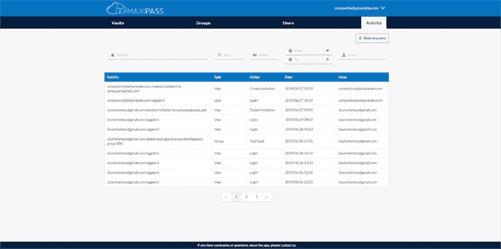Seven stages in the Software Development Life Cycle
Sample subdomains are shown in Figure 6, for the coarse mesh introduced in Section 3, on 8, 16 and 32 PEs. The formation of the linear equation system at each iteration proceeds independently on each subdomain, and requires no inter-PE communication. This step leads to a set of subdomain-level Jacobian matrices, which are being stored using Block Sparse Row (BSR) storage [11].

This makes it possible to quickly and accurately describe all the necessary technical points. And developers are well aware of this approach since they have the necessary knowledge and can quickly and efficiently develop systems according to the developed design. At present, more than 50 object-oriented methods have been developed, which are used as mechanisms for developing object models and building software systems based on them. The main concept of these methods is the object, as well as other definitions of the elements of the subject area that is created. The planning phase is the most critical step in creating a successful system.
Origin of Life Mystery May Finally Be on the Brink of a Solution Thanks to Electron Transport Chains
Architecture, and business architecture, and relies heavily on concepts such as partitioning, interfaces, personae and roles, and deployment/operational modeling to arrive at a high-level system description. This high-level description is then broken down into the components and modules which can be analyzed, designed, and constructed separately and integrated to accomplish the business goal. SDLC and SAD are cornerstones of full life cycle product and system planning. The software product development phase is where the designs, system architecture, and product functionality all come together in written code. That is where the software developers put their skills to work, building a digital product that brings the earlier specifications and requirements to life. This stage involves setting up infrastructure, frontend, and backend work, with you remaining informed throughout the process.
Some companies may find that baseline threat management or threat hunting programs (like MDR) are inadequate for the types of risks their IT assets are likely to face. Advanced analysis, like penetration testing, can address the most dangerous advanced persistent threats (APTs). Once all existing IT infrastructure is accounted for, companies need to project their future needs, both short and long term.
Why is Software Development Life Cycle Important?
The first stage of the asset management lifecycle involves initial planning, leading to targeted development or acquisition of needed IT assets. Companies should analyze all existing IT and security infrastructure at stage one, identifying all physical and virtual assets they currently own, operate, or oversee. This includes all computers, physical servers, and Internet of Things (IoT) devices, along with all software, files, and network architecture. Even though enterprise architects sometimes deal with technical questions, they delegate specific tasks to solution architects who then craft appropriate solutions. However, SA is not directly in charge of the execution process but makes sure that technical architects can successfully implement new IT solutions that are in line with all business requirements. While enterprise architecture focuses on strategy, solution architecture focuses on detailed planning.
- The company can then prioritize and develop a plan to implement and manage security controls, such as firewalls, intrusion detection systems, encryption, and multi-factor authentication.
- Given your budget constraints, it is beneficial for preliminary planning purposes and may help determine whether the project is achievable.
- As a result of this phase, we will have a functioning system ready for testing.
- This application development life cycle phase focuses on testing the written code for bugs and other inconsistencies.
- Depending on time constraints, you will gather a substantial amount of information to use during the next stage.
- You may also want to immerse yourself in your users’ physical environment to gain a deeper, personal understanding of the issues involved—as well as their experiences and motivations.
For a better overview, let’s compare five types of software development processes and their advantages and disadvantages. All these steps represent what it takes to gather project requirements https://www.globalcloudteam.com/ from the client under the SDLC methodology. This process is a part of the Planning & Requirement Gathering phase, which includes risk analysis, cost estimation, and proof of concept.
Product development process examples
Many of the data processing and execution capabilities of modern IT, such as conditional branches (if statements) and loops, are derived from the early work of Jacquard, Babbage and Lovelace. She brought these plans beyond simple math calculations and designed a series of operational instructions for the machine — now known as a computer program. The Analytical Engine would have been the world’s first general-purpose computer. But it wasn’t until the 1800s that the idea of programming devices really came along.
While aging units and computers may feel more familiar to your IT team, they will increasingly require more maintenance as they get older. Keeping them running without error will cost you more attention and time, which translates to losing money and increasing the potential for mistakes and failures. The older it gets, the more susceptible it becomes to things like glitches and slowing performance, meaning a need for more frequent support and higher costs. They formulate clear guidelines that help manage technical teams and outline the development stages of a project from start to finish.
IT strategic plan use cases
An effective consulting entails several practices that meet numerous purposes including estimation, competitive analysis, strategy development, implementation, management and support. After coming to the conclusion about the problems and requirements post-analysis, an IT consultant design and develop converged technology solutions to meet the requirement of the project. Apart from solution designing, in most of the cases, consultants also help in designing the project by picking the tools that will work best for the unique situation that is bounding the project. The action planning phase the first phase after the contract is signed between the client and the consulting firm. This is the phase where the consultant and the project members, firm up their action plans to address the problem, with defined goals to be achieved and set deadline.

Table 2 shows the results obtained for the cases of isothermal and non-isothermal mixing. As can be seen from Table 2 only for case study 1 were the same results obtained with local solvers OQNLP and SBB when compared to the solution obtained by global solver BARON. For other case studies involving isothermal mixing (Table 2) local solvers failed to give global solutions identical to the one obtained with BARON. Similar applied for case studies of non-isothermal mixing where OQNLP and SBB exceptionally found the same results as BARON for case study 1 and OQNLP, SBB and α-ECP for case study 2.
h European Symposium on Computer Aided Process Engineering
The organization begins to implement the projects and initiatives as outlined in the plan. This may involve procuring new hardware and software, training employees, and rolling out new systems or processes. IT Operations Analytics (ITOA) offer an effective approach for retrieving, reporting, and analyzing IT-related data, providing insight that can help you meet key IT consulting objectives for your IT operations. ITOA solutions provide visibility into all aspects of your IT operations and deliver value on several different levels. The anatomy of the IT asset management lifecycle comprises four primary stages—initial strategizing and procurement, integration into existing systems, ongoing asset maintenance, and safe disposal or archiving.

Holding on to old equipment will increase your chances of experiencing major technical issues, which can take anywhere from hours to days to fix, especially if you’re unprepared. Solution architect plays a central role in an organization’s efforts to introduce and successfully implement new technology solutions. Systems consist of single software tools or applications that people use to carry out their work. Solution architects rely on application architecture to create a map of all applications (usually in a layered structure) and how they interact with each other.
Security Risks
As your hardware and software systems age, your lifecycle management team will monitor and provide support. By paying attention to the lifecycle of your technology, you can understand when the best times to make upgrades are and keep up to date with maintenance. Sticking to scheduled maintenance and replacement dates will help your company mitigate potential risks and keep uptime levels high. The benefits of remaining attentive to your IT hardware lifecycle are varied.